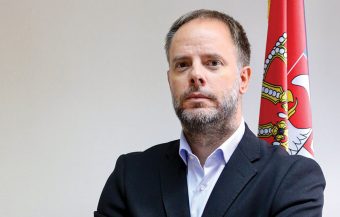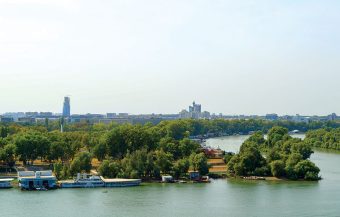
The Integrated National Energy and Climate Plan (INECP) of the Republic of Serbia is a key strategic document that defines ambitious yet achievable goals for the country’s energy transition. This plan is designed to guide Serbia toward a sustainable energy future, significantly increasing the share of renewable energy sources, improving energy efficiency, and reducing greenhouse gas emissions. Achieving the goals set out in the INECP should contribute to greater energy security, environmental protection, the modernization of the energy sector, and the improvement of the quality of life for citizens. Veljko Kovačević, PhD, State Secretary at the Ministry of Mining and Energy, speaks about the Integrated National Energy and Climate Plan for Energy Portal Magazine.
Q: What does the Draft Integrated National Energy and Climate Plan of the Republic of Serbia for the period up to 2030, with projections until 2050, bring?
A: The Integrated National Energy and Climate Plan is a key strategic document that defines the strategic goals and the timeline for their achievement in the energy transition process. We have set ambitious yet achievable goals whereby almost every other megawatt-hour of electricity will be green, the share of renewable energy sources (RES) in final energy consumption will reach 33.6 percent, and in electricity production, it will exceed 45 percent. Greenhouse gas emissions will be reduced by 40.3 percent compared to 1990, and the integration of the electricity market with the EU’s single market will be completed. One of the most important messages that INECP sends to the public is that we have conducted a detailed analysis of the baseline electricity production diagram and that all projections defined through the Stability and Stability-Progress scenarios have been made to ensure that the Republic of Serbia always has enough base energy, which is the only guarantee of the country’s energy security. Additionally, we will improve energy efficiency through building renovations and implementing policies in industry and transport, encourage electromobility, and increase the use of renewable energy sources in heating, cooling, and electricity production, as well as advanced biofuels.
Q: Energy efficiency is a special segment of the INECP. What is planned in this regard, and what national goals have been set accordingly?
In Serbia, three and a half times more energy is consumed in producing the same unit of GDP compared to the European average, which is why the Government and the relevant ministry have defined energy efficiency as one of the priorities within the INECP and the “Leap into the Future – Serbia 2027” plan. The INECP defines a limitation on final energy consumption to a level not exceeding 9.7 Mtoe by 2030. The same trend is observed in primary energy consumption, which is expected to be less than 14.68 Mtoe by 2030. The state is currently investing unprecedented funds to improve energy efficiency. In the past three years, more than 30,000 households received state subsidies for implementing energy efficiency measures. By the end of 2027, we will support over 70,000 households in replacing windows, improving insulation and facades, replacing inefficient boilers, and installing solar collectors or panels for generating electricity for personal use. In cooperation with the World Bank, we secured $50 million for household subsidies, which can cover up to 65 percent of the value of energy renovation measures, while socially vulnerable groups receive grants covering 90 percent of the costs.
IN FOCUS:
- Energy Security Through the Development of the Prosumer Market
- We Are Actively Reducing CO2 Emissions in Our Operations
- Old Press In a New Guise

In addition to household energy renovation, we are implementing the Public ESCO Project in collaboration with the European Bank for Reconstruction and Development (EBRD), valued at 64.5 million euros, which focuses on the energy renovation of residential buildings connected to district heating systems and the transition to consumption-based billing in 14 cities and municipalities. It is estimated that more than 500 residential buildings, covering an area of about one million square meters, will be renovated as part of the project. Grants will cover the costs of preparing energy efficiency reports and relevant studies, as well as 50 percent of the investment value, while citizens will repay their share of the investment through their heating bills.
The Ministry of Mining and Energy is investing significant funds in improving energy efficiency in public buildings across Serbia. This year, we allocated 800 million dinars in the budget for these purposes, twice as much as in 2023. We signed contracts with 41 local government units to conduct energy renovations of kindergartens and preschool institutions, elementary and high schools, faculties, libraries, cultural centers, healthcare institutions, and municipal administration buildings. By completing the energy renovations, we will save about 9,000 MWh of thermal and electric energy annually while reducing carbon dioxide emissions, which will amount to about 5,500 tons per year. In renovated buildings, energy consumption will decrease by 20 percent to 50 percent.
We are also paying great attention to the energy renovation of central government buildings. We have secured funds for the energy renovation of 26 out of 56 buildings, including the Palace of Serbia, and these works should be completed by 2027, when the specialized EXPO exhibition will be held.
What does INECP bring when it comes to renewable energy sources?
With the adoption of the Integrated National Energy and Climate Plan, Serbia has gained a strategic document aligned with Europe’s vision of decarbonizing the energy sector, thus representing Serbia’s “roadmap” for energy transition. This plan is tailored to the characteristics of our energy sector and the imperative that, at all times, our citizens and economy can rely on a secure supply.
The Integrated Plan emphasizes investments in renewable energy sources. About 3.5 gigawatts of new solar and wind power plants are expected to be connected to the grid by 2030, meaning that almost every other megawatt-hour of electricity produced will be sourced from clean energy.
Interview by Milica Radičević
Read the whole interview in the new issue of the Energy portal Magazine ENERGY TRANSITION

